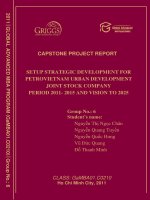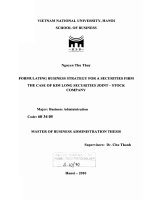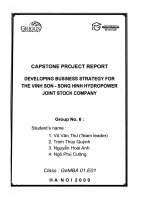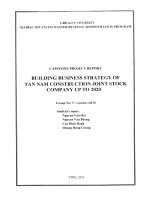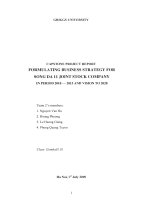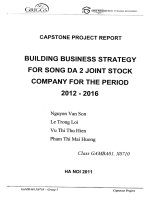BUILDING THE BUSINESS STRATEGY PHASE 2011 2015 AND ORIENTATION TO 2020 OF SONG DA FINANCIAL JOINT STOCK COMPANY
Bạn đang xem bản rút gọn của tài liệu. Xem và tải ngay bản đầy đủ của tài liệu tại đây (493.64 KB, 76 trang )
Thesis topic
BUILDING THE BUSINESS STRATEGY
PHASE 2011 - 2015 AND ORIENTATION
TO 2020 OF SONG DA FINANCIAL
JOINT STOCK COMPANY
1
TABLE OF CONTENT
No.
Content
INTRODUCTION
Page
7
1 Reason for selecting the topic
7
2 Objective of the study
7
3 Scope of the study
7
4 Method of the study
7
5 Structure of the capstone project
7
CHAPTER 1: THEORY FRAMEWORK
1.1 Theory on business strategy of enterprise
9
1.1.1 Some concepts of strategy
9
1.1.2 Essence of business strategy
9
1.1.3 Characteristics of business strategy
10
1.2 Process of building strategy
12
1.3 Model of external environment analysis
13
1.3.1 Model – Macro analysis
13
1.3.2 Five Forces Model of Michael - Industrial analysis
16
1.4 Model of internal analysis
18
1.4.1 Value chain
18
1.4.2 Sustainable competitive advantages of enterprise
20
1.5 General analysis model (SWOT)
21
1.6 General competitive strategies
22
1.6.1 Cost-leadership strategy
22
1.6.2 Product differentiation strategy
23
1.6.3 Concentrated growth strategy
24
1.7
Analysis model selecting strategy of weighting method
25
CHAPTER 2: ANALYZING THE REAL SITUATION OF SONGDA
FINANCE JOINT STOCK COMPANY
2.1 Overview on SongDa Finance Joint Stock Company
2.1.1 Process of establishment and development
27
27
2
2.1.2 Business lines of the Company
27
2.1.3 Organizational structure of the Company
28
2.1.4 Achievements in 2008-2010 period
29
2.1.5 Some notes about the development history of SDFC
30
2.1.6 Business situation
30
2.2
Analyzing external environment of SongDa Finance Joint Stock
Company
35
2.2.1 Analyzing macro environment of SDFC
35
2.2.2 Analyzing micro environment of SDFC – Industrial environment
40
2.3
48
Analyzing internal environment of SDFC
2.3.1 Value chain model
48
2.3.2 Sustainable competitive advantages
55
2.4 SWOT analysis of SDFC
58
2.5 Vision, Mission and Strategic Objective of SDFC to 2020
63
2.5.1 Vision
63
2.5.2 Mission
63
2.5.3 Strategic Goals by 2015 and 2020
63
2.6
Selecting business strategy for SDFC according to weighting
method
66
CHAPTER 3: SOLUTIONS, RECOMMENDATIONS AND
CONCLUSION
3.1 Some solutions to successfully implement the selected strategy
71
Boosting the establishment and development of human resource with
3.1.1 advanced management and high-qualified and professional human
resource
3.1.2
71
Optimizing management process to reduce the cost of goods sold
of financial services, raise quality and pre-eminence of products.
3.1.3 Investing in information technology and modern infrastructure
72
72
Ensuring the diversification of channels for mobilizing capital,
3.1.4 mobilize enough capital and optimally balance capital structure and
time-limit for business
73
3
3.1.5
Concentrating resources to establish subsidiaries and joint-venture
companies in the strong fields of the company
73
Some recommendations, shortcomings and following orientation
3.2 of the study
74
3.2.1 Some recommendations
74
3.2.2 Shortcomings of the study
75
3.2.3 Orientation of study in the future
75
3.3 Conclusions
75
DEFINITIONS
Within the scope of this report, the following abbreviated terms are construed as
follows:
ACB
ASEAN
ATM
BIDV
BIM
EVNFC
Eximbank
: Asia Commercial Bank
: Association of Southeast Asian Nations
: Machine and withdraw cash payment automatically
: Bank for Investment and Development of Vietnam
: Bao Minh Insurance
: Electricity Viet Nam Financial Company
: Export and Import Bank
GDP
: Gross domestic product
M& A
: Mergers & Acquisitions
MB
: Maritime Bank
MIC
: Military Insurance Company
PVFC
: Petro Viet Nam Financial Company
PVI
: Petro Vietnam Insurance
Sacombank
: Sai Gon Commercial Bank
SBU
: Sub Business Unit
SDFC
: Song Da Financial Joint Stock Company
Vietcombank : Joint Stock Commercial Bank for Foreign Trade of Vietnam
4
WTO
: World Trade Organization
List of Table and Figure
Page
Figure 1-1 : Model of strategic management process
12
Figure 1-2 : External environments
13
Figure: 1-3 : Diagram of industrial competition
16
Figure: 1-4 : Value chain diagram
19
Table 1- 1 : Selecting strategy option according to weight method
26
Figure 2-1 : Management model of the Company
29
Table 2-1 : Capital mobilization by year
31
Table 2-2 : Balance of debit by year
31
Table 2-3 : Classification of lending forms
32
Table 2-4 : Data on the security rate and risks management
32
Table 2-5 : Business result in last 3 years
34
Table 2-6 : Criteria of efficiency
34
Figure 2-2 : Value chain
53
Table 2-7 : Labor structure as of December 31, 2009
54
Figure 2-3 : SWOT matrix of SDFC
61
Table 2-8 : Select an appropriate strategy by using the weighting method
68
5
PREFACE
1.
Reason for choosing the subject:
Becoming the 150th member of the World Trade Organization (TWO) on January
11, 2007 affirms that Vietnam’s economy in general and Vietnamese enterprises in
particular have integrated into the world economy deeply and widely. Vietnamese
enterprises have been renewing their thought of business and reaped certain success.
To develop and integrate into the world economy successfully, Vietnamese
enterprises need to ceaselessly renovate and raise the adaptability to the market and
clearly define the destination that the enterprises need to reach. How to reach it and
by which mean? Therefore, they need to have business strategy. Sound and
reasonable business strategies will insure the sustainable development of enterprises
on the basis of effectively implement enterprises’ goals.
2.
Objective of the study.
-
Studying and systemizing theories, selecting effective model of analysis to
building and implementing business strategy.
-
Applying the system of theoretical bases and models to analyze internal and
external environments and building business strategy of the Company.
-
Suggesting solutions and recommendations to the Company in implementing
business strategy to complete the selected business strategy;
3.
Scope of the study:
Studying and analyzing business lines of SongDa Finance Joint Stock
Company.
4.
Method of the study
The report mainly used quantitative analysis method. Methods of collecting
data such as using questionnaires, interviewing experts were used. Using national
6
statistical data, information and specific data; using secondary data about strategy
and previous reports of the Company.
5.
Structure of the Capstone Report
Chapter 1: Theory framework
Chapter 2: Analyzing real situation of SongDa Finance Joint Stock Company.
Give an overview of SongDa Finance Joint Stock Company. Business
strategy to 2015 and vision to 2020. Apply models of analyzing external
environment affecting the enterprise – Five forces model. Apply the model of value
chain and sustainable competitive advantage to analyze the internal of the
Company. Apply SWOT analysis to have an overall evaluation to find out the
strengths, weaknesses, opportunities, and threats. Analyzing and selecting business
strategy for the Company according to weighting method.
Chapter 3: Recommendations and conclusion
Some solutions to successfully implement the selected business strategy,
some shortcomings and recommendations to solve these shortcomings and
orientation for further studies in the future.
The End is references.
7
CHAPTER 1: THEORY FRAMEWORK
1.1.
Theories on Business Strategy of Enterprise
1.1.1. Concept of Strategy and Strategic Management
•
Concept of strategy
-
Strategy is model of goals, objectives and plans to achieve those goals
(Kenneth, 1965);
-
Strategy and formation of a unique and valuable position include the
differentiation, a bartering selection to mostly concentrate resources to
generate advantages for an enterprise... (Michael Porter)
-
According to group 7, “Strategy is a system of coherent and long-term
measures and methods that an enterprise tries to implement to gain the
clearer and more outstanding differentiation compared to its rivals to
achieve a set goal”.
•
Concept of strategic management
-
According to Alfred Chandler, strategic management is the process of identifying
basic and long-term goals of an enterprise, selecting mode or orientation of action
and distribution of vital resources to implement those goals.
-
According to John Pearce and Richard B.Robinson, strategic management is a system
of decisions and actions to form and implement plans to attain goals of an enterprise.
-
According to group 7, “Strategic management is a systematic process from
building strategy, developing strategy, controlling and evaluating strategy to
achieve the targets set by an enterprise.
1.1.2 Essence of Business Strategy
Business strategy is a business model of enterprise, in terms of business strategy, is
the platform of business activity; method of using resources; basis for handling all
matters of the business.
8
Business strategy is the creation in management, which means that business, based
on certain objectives to form a new effective and competitive management system.
Therefore, business strategy is preceded from the actual situation of the
enterprise. Two businesses in the same area, same product, same size, but the
business strategy can not completely be the same because of their different subjective
condition. At the same time the creative management must combine closely with
organizational creativity, technical innovation can promote the work of business
strategy.
Business strategy is to show the competitive position of enterprises, while building
their business strategy, enterprises need an objective analysis of their situation,
explore opportunities and challenges that affect the objective circumstances to
business. Study of subjective conditions of the business to know the strengths and
weaknesses and base on these actual situations to achieve the objective of the
enterprise
1.1.3. Characteristics of Business Strategy
•
Conformity
The conformity of business strategy is reflected on three aspects: It needs to
be consistent with the dominant trend of development and the motto directing the
activities of the enterprise and needs to be in line with the development trend of the
country in economic, technical and social aspects in a certain period of time; and
needs to be conformable with the trend of world economic integration.
•
Predictiveness
In the past, due to having no strategy planning, doing activities spontaneously
and following movement, many enterprises worked hard but ineffectively. One of the
causes of that situation is the lack of understanding about the development trend of
the enterprises. Therefore, to build business strategy, there must be good forecast on
the economic and technical development trend of the society.
9
•
Competitiveness
If there is not competition, it is not necessary to have business strategy; thus,
when building business strategy, we need to know how to get businesses a
competitive edge over rivals and therefore win the competition.
•
Risks
Business strategy is the planning the enterprise’s development in the future. The
longer-term the strategy is, the riskier the strategy is, requiring entrepreneurs to have a
prudent and objective vision and observation to have a sound strategy. Business
strategy should not be too long-term and needs to insure the flexibility and practicality.
•
Professionalism and Creativeness
Enterprises can base on their internal power to select a suitable field of operation
and avoid the industry in which big enterprise has dominant position. However, the
technological advancement and competition in the market is unlimited; therefore,
enterprises need to ceaselessly specialize and invent suitable technology and
important measures to insure their existence and development.
•
Relative Stability
Business strategy of enterprises needs to have a relative stability in a certain period
Otherwise, it will not have any steering implication to the real operation of the
enterprise. Business strategy also needs to be adjustable to suit the objective
situation
10
1.2.
Process of Building Strategy.
Figure 1-1: Model of strategic management process
Mission & Objective
External analysis
(Oppotunities and
Threats)
Selecting and building
strategies
Internal analysis
(seeking resources,
capacities...).
Functional strategy
SBU strategy
Global strategy
Corporate strategy
Structure
Adjust strategy,
structure and supervise
Supervise
Change strategy
(Source: Strategy Management – Statistical Publishing House 2009)
•
Vision
A correct vision will help enterprises analyze and approach the overall business
environment and find out the real advantages and disadvantages influencing the
production and business activities of the enterprise.
11
•
Mandate of the enterprise
Determining current missions, goals and strategies of the enterprise is the starting
point of strategic management. When having developed in a business environment that
contains full of fluctuations, managers need to redefine the initial goals.
•
Goals and mission of the enterprise
Insuring the agreement on the internal goals of the Company, establishing a
common voice or corporate environment; facilitating the introduction of goals and
work structure relate to the allocations of missions
1.3.
Model of External Environment Analysis:
1.3.1. Macro Analysis
Figure 1-2 : External environments
Economi
c
Demographi
c
Industrial
environment
Cultural
- Social
Threats of new entrants
Bargaining power of suppliers
Bargaining power of buyers
Threats of substitute products
Competitive intensity
Environment
Global
Political/Legal
Technological
(Source: Lecture on strategic management – Gamba)
12
• Analyzing Economic Environment
Status of the macroeconomic environment determine the health, economic
prosperity, it always affects businesses and industries. Therefore, enterprises must
study the economic environment to identify changes, trends, implications of its
strategy. There are four important factors in the macroeconomic environment that is
growth of the economy, interest rates, exchange rates and inflation rates.
•
Economic Growth: leading to the explosion of spending by customers,
so it may tend to bring more relaxed about competition in the industry
and tends to reverse when the economy declined.
•
Interest rates: It may affect the demand for products and services of the
business. Interest rates are important factors when consumers to borrow
to finance their purchase operations for goods and services.
•
Exchange rate: Determining the value of national currencies with one
another. Movement of exchange rates has a direct impact on the
competitiveness of enterprises on the global market.
•
Inflation: Can reduce the stability of the economy, making the economy
grow more slowly, higher interest rates, exchange rate shifts are not
stable. If inflation increases, investment planning becomes risky. Bad
investments held out of business, in case of inflation, will reduce the
economic activity, eventually pushing the economy to stagnate
place. Thus, high inflation is a threat to the company.
• Analyzing Demographic Environment
•
Population scale: Observing the demographic changes in terms of
population to highlight the importance of this segment. The projection
on population shows the global challenges related to population of the
21st century and opportunities for businessmen.
13
•
Age structure: showing the opportunities of services, but it also
contains new threats related to human resource for enterprises.
•
Geographical distribution: This may create advantages for technology.
With computers, people can stay at home and exchange with other
people via the telecommunication network.
• Analyzing Political and Legal Environment
•
Political Environment: consists of political factors and contexts whose
operation has influence on the business of the enterprise. These factors
include political regime, political party, political union, policies of the
Party and State, political atmosphere of the society.
•
Legal Environment: This is the legal system related to the enterprise,
including normative law, legal sense of the judicial agencies, executive
agencies and the enterprise. Influence of political and legal environment
to the enterprise is very deep and even has dominant implication.
• Analyzing Scientific and Technology Environment
Many new techniques invented and applied quickly has been knowledged and
revolutionized the entire economies of developed countries. That will change the
scientific, technical and technological environment of the society, promoting
technological innovation, technology of the society as well as boosting the current
technology transfer and industry restructure. Enterprises should identify changes,
implement and apply technical advancement and upgrading the technology.
• Socio-Cultural Environment
•
Social environment: It includes the formation, changes of social classes,
population structure, migration, etc. All the status and variation of the factors
can have influence on the operation of enterprises.
14
•
Cultural environment: include factors related to philosophy, religion,
language, literature and art. These factors have indirect influence on the
operation of enterprises and should not be underestimated
• Global environment
Global environment includes related international market, current markets that are
changing, important international events and basic institutional and cultural characteristic
on global market. Macro-environment analysis allows the evaluation of macro-economic
factors that have influence on business activities of enterprises and changes in
competitive environment.
1.3.2. Five Forces Model – Industrial Analysis
Five forces model by Michel Porter is summarized in following 1- 3 figure:
Figure 1-3 Diagram of industrial competition
Threats of new entrants
Bargaining power
of suppliers
Competitive rivalry
within an industry
Bargaining power of
buyers
Threats of
substitute products
(Source: Strategy Management – Statistical Publishing House 2009)
• Threats of new entrants
New entrants may be newly-established enterprises joining the market or
enterprises that previously traded other types of products, now trade many types of
products. These enterprises bring about new production capacity to the industry, but
also require a certain market share. Whether this competitive pressure is great or
insignificant depends on the expenses of an enterprise when participating in the
15
market and the level of reaction of other enterprises when that enterprise
participates in the market and depends on the industry entry barriers.
• Threats of substitute products
Substitute product is a product of similar use. If the profitability of the
substitute product is high, the competitive pressure will be great and make the
enterprise passive. If the manufacturer of the substitute product rapidly develops
production, the industry will be under a strong threat. If consumers accept the
substitute product smoothly both in terms of economics or psychology, that
threat will be greater.
• Bargaining power of buyers
Enterprises’ customers can request that the prices of goods or services to
be cheaper along with higher satisfaction on service quality. The problem is who
are the main customers having the power to negotiate and need the attention of
the enterprise. Those users give criteria of price, quality, technology, date of
completion, etc. It requires enterprises to have capacity to be willing to meet
requirements during the competition process.
• Competitive rivalry within the industry
The competition among enterprises in the same industry is expressed via the
patterns, characteristics of competition, relating to the following factors:
-
The business may base on the assignment of the industry, position and role of
the industry in the process of social production, resources used by the industry,
the prospect of the economy, consumers’ habits, etc. Via those analyses to
understand the characteristics of the industry and have appropriate policies.
-
Structure and scale of enterprises in an industry usually come in two forms.
Firstly, the structure and scale of big enterprises will be very big and those of
small enterprises will be very small. In this case, the competition is not very
tough because big enterprises have gained absolute dominant positions.
Secondly, big enterprises are not too big; the small enterprises are not too
16
small. In this case, the competition will be fierce because the internal powers
of enterprises in the industry do not vary much.
-
In general, the structure of number of enterprises in the industry is large, it will prove
that the market size is significant and the market entry barriers are relatively small.
-
Market structure in the industry, the supply and demand in the market, oversupply, supply and demand is balance or over-demand. If demand exceeds
supply, there must be investigation of form of market entry with certain
advantages. If the supply-demand is balance, enterprises should reinforce
their strengths. If supply is greater than demand, enterprises should consider
the creation of competitive advantage or withdrawal from the industry.
• Bargaining power of suppliers
Suppliers in the banking sector is quite diverse, they can be the bank's
shareholders, or partners, enterprises having ample financial resources and often supply
capital to banks or customers have the ability to negotiate on prices. Credit institutions
are interested in the bargaining power to suppliers to address the requirements of
quality, product prices and the capacity of capital advancement and turnover.
1.4. Analysis Model of the Internal Of the Enterprise:
1.4.1. Value chain
The value generated of an enterprise is measured by the amount that buyers
who are willing to pay for products or services. The division of activities in the
value chain creates favorable conditions for investing costs and result of each
activity, finding the way to improve each activity, combining them according to the
strategy to generate value of each specific product as well as of the enterprise.
Activities supporting for key activities are specified as follows:
• Developing technology: developing products and manufacturing technology.
Developing technology can lower production cost, creating more attractive
products and sell at higher prices.
17
• Human Resource Management: Human resource is the most precious asset of
the enterprise. High-quality human resource and an effective apparatus are
important factor for the success of the enterprise.
• Company Infrastructure: Infrastructure includes organizational structure,
executive systems and culture of the enterprise. Via the management power,
senior managers can actively shape the infrastructure of the enterprise and
through which all activities to create other value is done.
Figure 1 – 4 Value chain diagram
In
te
re
st
t
es
r
te
In
Services
Marketing & Sales
Logistics outside
Production
Logistics inside
Pur
cha
sin
g
Tec
hn
olo
gy
dev
elo
pm
ent
Hu
ma
n
res
ou
rce
ma
na
ge
me
nt
In
fr
as
tr
uc
tu
re
Basic activities
(Source: Lecture on strategic management – Gamba)
18
S
u
p
p
or
ti
n
g
ac
ti
vi
ti
es
1.4.2. Sustainable Competitive Advantages of the Enterprise
• Competitive advantages of the enterprise is constituted from 4 factors:
The first is the knowledge and technological capacity of the staff including
knowledge and skills of each employee; and qualities and knowledge structure of
the whole staff.
The second is the technical system of the enterprise or the crucial system of
techniques to implement the business strategy of the enterprise.
The third is the management system of the enterprise, the enterprise’s
strengths
formed
through
regimes,
regulations,
organizational
structure,
organization plan, and leadership, encouragement of the enterprise and the leader’s
art of leading.
The fourth is the concept of value and the enterprise’s culture system, the
important constituent of the enterprise.
• The analysis of competitive advantages of the enterprise - needs to solve 3
problems:
-
What are the competitive advantages of the enterprise? How is their status?
To solve this problem, we need to analyze in-depth resources, technical
system, management and corporate culture of the enterprise.
-
What is the effect of competitive advantage on the competitive strengths of
the enterprise? Generally, the unique the competitive advantage of the
enterprise is, the longer the time for maintaining the strength is and the
firmer the competitive strength is.
-
How to develop and foster the enterprise’s competitive advantage? The
development and fostering the enterprise’s competitive advantage often
include the investment and revive the human resource of the enterprise,
ceaselessly raise the technical quality of the staff, timely renovate
19
management structure to be able to make it operate smoothly and
harmoniously with the objective environment.
1.5.
SWOT Analysis
SWOT analysis is used to analyze strengths, weaknesses, opportunities and
threats of an enterprise to determine a suitable business strategy, promote strengths
of the enterprise and overcome weaknesses in making full use of business strategy
as well as challenges from the external environment.
SWOT analysis is the key to develop strategy and clarify the internal power of the
enterprise; strengths, weakness, opportunities and threats from the outside.
• Strengths
What are the strengths of the enterprise? What is the best task done by the
enterprise? What are the advantages that people see from the enterprise? The issues
must be considered by the enterprise and other people. Strengths are formed when
comparing with competitors.
• Weaknesses
Which weaknesses can be improved? Which tasks are best done? What needs to be
avoided? The above issue needs to be considered both internally and externally.
Other people can see weaknesses that the enterprise does not recognize. Why do
competitors can do better? This matter should be viewed practically.
• Opportunities
Where the good opportunities are? What is the existing trend that should be paid
attention? Opportunities may come from the changes of technologies, policies of the
State, social pattern, population structure, etc. The most effective method to find is
to check the enterprise’s strengths and pose the question “whether those strengths
can lead to any new opportunities? The enterprise can do reversely – check its
weaknesses and pose the question “whether there is any opportunity to remove
them?”
• Threats
20
What are the current obstacles? What competitors are doing? Whether there is any
change in the work, products or services? Is there any problem related to overdue
debts or the cash flow? Which weaknesses are threatening the Company? These
analyses often help to find what need to be done and turn weaknesses into
prospects.
1.6.
General Competitive Strategies
1.6.1. Cost-Leadership Strategy
This strategy has two basic advantages. Firstly, with lower price, the cost leader
can set the lower price compared to its rival while still gain equal profit to the rivals.
Secondly, is the competition in the industry increases and enterprises compete in price,
the cost leader will likely to stand firmly in competition rather than other enterprise
because of its lower cost.
• Strategic Solutions
Product differentiation is often costly. Therefore, the cost for this is not too
different compared to rivals using product differentiation strategy; to make the
differentiation has a low cost, the cost leader often skips different market segments
and pays attention to the market in a large scale. In fact, enterprises often set lower
price compared to their rivals to attract customers to their products.
• Advantages
In the most general way, measures to have enterprises gain cost-related
advantages vary by each industry and structure of industry. Some advantages may
come from the production scale, technological monopoly, preferential on materials,
components of products, the service quality, technical process, etc. The advantage
of each basic strategy is best demonstrated by Porter’s Five Forces Model. The costleadership strategy is protected from competitors in the sector by its own cost; the
low cost also means that it will be less impacted by the competitors in the case of
increasing input cost and the discount of products when buyers have better
bargaining power; cost-leadership often strongly requires the enhancement of direct
21
bargaining power with suppliers; of substitute products join the market, with low
cost, cost leader can reduce price to compete and sustain its market share;
• Disadvantages
The main threats of cost-leadership strategy lies in the ability of competitors
in finding the way to produce with lower cost and attack the cost leader by its own
“forte”. The possibility that competitors will imitate the methods of the cost leader
is a threat to the cost-leadership strategy; there is a threat that the cost-leader only
thinks about cost and unlikely to be able to follow the changes in the taste of
customers. It may make decision to reduce cost, but the decision will have visible to
the demand for the product.
1.6.2. Product Differentiation Strategy
The purpose of product differentiation strategy is to gain competitive
advantages by creating products, goods or services are recognized as unique in
customers’ reviews. It is likely that an enterprise differentiates its product to meet
consumers’ demand in a way that competitors cannot. The possibility to increase
revenue by achieving a high price allows the strategy users to have better
performance than their competitors and gain higher profits.
• Strategic Solutions
Product differentiation can be attained in three main ways, namely quality,
innovation and adaptation to customers. The renovation is very important for
complicated technological products. The attraction of the products satisfies the
expectation about the origin of the differentiation. A strange psychology of
customers can become the source of product differentiation. The attraction may be
the factors associated with status or pride of the age groups or socioeconomic
groups. In fact, the basis of product differentiation is infinite.
The product differentiation is the basis for innovation, technological
capability and depends on the function of research and development.
• Advantages and Disadvantages
22
Difference from competitors, product differentiation brings about the loyalty
of customers with the brand, a very valuable asset. New enterprises are forced to
create their own capacity to be able to compete with existing brands and this task is
very costly.
Product differentiation does not allow enterprises underestimate the matter of
cost; the cost difference needs to be greater than the supplemented cost to generate
differentiation to reach an equivalent cost or nearly equivalent cost to competitors.
Therefore, there must be a cost reduction in the parts that do not influence the
product’s differentiation.
A company can also reduce production costs and marketing expenses if it
limits the number of models in the product line by selling a package of "options" of
products rather than letting the consumers to decide which options they want. A
timely storage system can also help reduce costs, improve quality and reliability of
the enterprise’s products.
1.6.3. Concentrated Growth Strategy
Concentrated growth strategy is different from the two above strategies because
it orients to serve the demand of a limited group of customers or market segment.
Enterprises following concentrated growth strategy will focus on serving a specific
market segment which can be defined according to geography, type of customer or a
branch of the product line. In nature, an enterprise following concentrated growth
strategy is a product-differentiation enterprise or a cost leader.
Another characteristic is that enterprises following concentrated growth strategy
compete with the ones following product differentiation in only one or a few market
segments in which the product differentiation is successful because they only have
knowledge about a small group of customers or about the region. Moreover, the
concentration on a small chain of products sometimes allows people to make
innovation quicker than a big differentiation.
• Strategic Solutions
23
Concentrated-growth enterprises select a market segment to compete in
rather than the whole market as the cost leaders or satisfy a large number of market
segments like followers of product differentiation strategy in general; enterprises
following concentrated growth strategy can have many methods to develop their
competitive advantages and this explains why there are too many small enterprises
compared to big ones. A concentrated-growth enterprise has many opportunities to
develop specific activities and compete with low-cost enterprises and productdifferentiation enterprises which are increasing.
• Advantages and Disadvantages
The competition of concentrated-growth enterprises comes from the origin of
its own capacities – efficiency quality, renovation or adaptability to customers. It is
protected from competitors at a certain level in which it can supply products and
services that competitors cannot. However, to suppliers having bargaining power,
concentrated-growth enterprises are disadvantageous because they purchase
materials with a small volume; therefore, bargaining power belongs to suppliers.
However, as long as they can turn the increase in price to its loyal customers, this
disadvantage is insignificant and the generation of loyalty to customers also reduces
threats of substitute products. Another advantage of concentrated growth strategy is
that it allows enterprises to come closer to customers and timely response to their
changing demand.
Because enterprises following concentrated growth strategy produce a small
volume of product, so their production cost will be higher compared to costleadership followers; the higher costs may lower the profit if followers of this
strategy are forced to invest more in developing a specific capacity; the market
segment of these enterprises can suddenly disappear due to the changes in
technology or customers’ taste. The disappearance of market segment is also a
cause for the failure of small enterprises. There is a threat that enterprises following
product differentiation strategy will compete to gain the market share of
concentrated-growth enterprises.
24
1.7.
Model of Analyzing and Selecting Strategy According to Weighting
Method
Weighting method selects a strategy in a series of options given on the basis
of assessing criteria for selection such as value of the enterprise, revenue, profit, the
suitability with corporate culture, etc. to find out the best strategy. This method
consists of 4 steps:
* Step 1: Selecting the most important and suitable criterion with the
characteristic of the enterprise to evaluate competitive strategy as well as the value
of the enterprise, revenue, profit, competitive advantages, etc. This is a subjective
step of the chooser.
* Step 2: Imposing weight to criteria to determine the important of criteria
having influence on the final decision.
* Step 3: Marking each option of strategy according to each criterion.
* Step 4: Calculating the sum of products to find out the option with the highest
mark. This will be the selected option.
Table 1- 1: Selecting strategy option according to weight method
Strategy A
Criteria
Weight
Mark
Product
Strategy B
Mark
Product
Strategy C
Mark
Product
Value of owners
Corporate culture
Competitive advantages
gained
Investment capital
Revenue
Total
(Source: Strategic option and select – Focus of strategic planning –
Abraham 1999)
25
